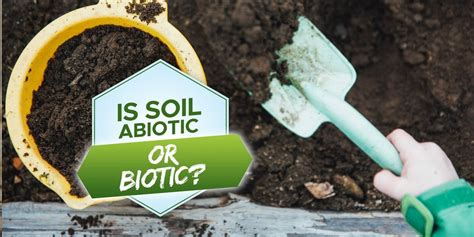Soil, the foundation of terrestrial ecosystems, has long perplexed scientists with its dual nature. Consisting of both living and non-living components, soil defies a clear classification as either abiotic or biotic.

Abiotic Components of Soil
The abiotic components of soil include:
- Mineral particles: weathered fragments of rocks and minerals, such as sand, silt, and clay
- Organic matter: decomposed plant and animal residues in various stages of decay
- Water: present in soil in varying amounts, from dry to saturated
- Air: occupying the pore spaces between soil particles
- Nutrients: essential elements for plant growth, such as nitrogen, phosphorus, and potassium
Biotic Components of Soil
The biotic components of soil include:
- Microorganisms: bacteria, fungi, algae, and protozoa that decompose organic matter, cycle nutrients, and contribute to soil structure
- Mesofauna: organisms between 0.2 and 2 mm in size, such as mites, springtails, and collembola, that contribute to soil aeration and organic matter turnover
- Macrofauna: organisms larger than 2 mm, such as earthworms, nematodes, and ants, that mix soil, improve drainage, and transport nutrients
- Roots: extend into soil and absorb water and nutrients while anchoring plants
- Decomposition products: enzymes, hormones, and other chemical compounds released by microorganisms and other soil organisms
The Continuum of Abiotic and Biotic
The abiotic and biotic components of soil exist in a dynamic equilibrium, constantly interacting and influencing each other. For example, microorganisms decompose organic matter, transforming it into nutrients that are then absorbed by plant roots. In turn, plant roots create channels for water and air to penetrate deeper into the soil profile. This interplay between abiotic and biotic factors is essential for maintaining soil health and productivity.
Why Soil Abiotic-Biotic Distinction Matters
Understanding the abiotic and biotic components of soil is crucial for several reasons:
- Soil management: Soil health depends on the balance of abiotic and biotic factors. Proper management practices, such as crop rotation, cover cropping, and reduced tillage, can enhance soil biodiversity and improve soil structure.
- Climate change: Soil plays a vital role in carbon sequestration. The organic matter in soil stores carbon dioxide, mitigating climate change. Soil management practices that increase organic matter content can contribute to climate mitigation.
- Water quality: Soil acts as a filter for water, preventing pollutants from reaching groundwater and surface water. Healthy soil with a diverse microbial community can help break down contaminants and improve water quality.
- Ecosystem services: Soil supports a wide range of ecosystem services, including plant growth, water filtration, and habitat provision. Understanding the abiotic and biotic interactions in soil is essential for safeguarding these services.
Abiotic-Biotic Interactions in Soil
The interactions between abiotic and biotic components of soil create complex processes that contribute to soil health and ecosystem functioning. Some examples include:
- Nutrient Cycling: Microorganisms break down organic matter, releasing nutrients that are essential for plant growth. These nutrients then interact with mineral particles and water to form various nutrient pools that are available to plants.
- Soil Structure Formation: Plant roots, microorganisms, and soil animals help create and maintain soil structure. They secrete sticky substances that bind soil particles together, forming aggregates that improve soil aeration and water infiltration.
- Water and Air Dynamics: The pore spaces between soil particles allow for water and air to penetrate and circulate in the soil profile. The size and connectivity of these pores are influenced by the abiotic and biotic components of soil.
- Disease Suppression: Soil microorganisms can release antibiotics and other compounds that inhibit the growth of plant pathogens. This interaction helps protect plants from diseases and contributes to soil health.
Future Research and Applications
The field of soil ecology is constantly evolving, with new discoveries shedding light on the intricate abiotic-biotic interactions in soil. These discoveries have implications for agriculture, environmental management, and climate change mitigation.
Innovative Applications:
The abiotic-biotic distinction in soil offers inspiration for innovative applications:
- Bioremediation: Utilizing the biodegradative capabilities of soil microorganisms to clean up polluted soils and groundwater.
- Soil Health Testing: Developing rapid and cost-effective methods to assess soil health based on the analysis of abiotic and biotic soil components.
- Precision Agriculture: Using abiotic and biotic soil data to develop site-specific crop management practices that optimize yields and reduce environmental impacts.
Frequently Asked Questions (FAQs)
Q: Is soil considered living or non-living?
A: Soil is a complex system that contains both living and non-living components. It is considered a living or biotic system due to the presence of microorganisms, insects, and other organisms.
Q: What is the role of organic matter in soil?
A: Organic matter provides nutrients for plants, improves soil structure, and supports beneficial soil microorganisms. It is a key indicator of soil health and fertility.
Q: How does soil contribute to climate change?
A: Soil acts as a carbon sink by storing carbon dioxide in its organic matter. Healthy soil with high organic matter content can help mitigate climate change.
Q: What are the benefits of maintaining soil health?
A: Healthy soil supports plant growth, regulates the water cycle, protects water quality, and provides habitat for a variety of organisms.
Q: What is the impact of urbanization on soil?
A: Urbanization can lead to soil compaction, loss of biodiversity, and increased pollution. It is important to implement measures to protect soil health in urban areas.
Q: What are some ways to improve soil health?
A: Practices that improve soil health include reducing tillage, adding organic matter, practicing crop rotation, and managing soil moisture effectively.
Q: How can soil be used to restore degraded ecosystems?
A: Soil can be used in restoration projects to create new habitats, improve soil quality, and support plant growth.
Q: What are the potential threats to soil health?
A: Threats to soil health include erosion, pollution, urbanization, and climate change. It is important to implement measures to protect and conserve soil resources.
